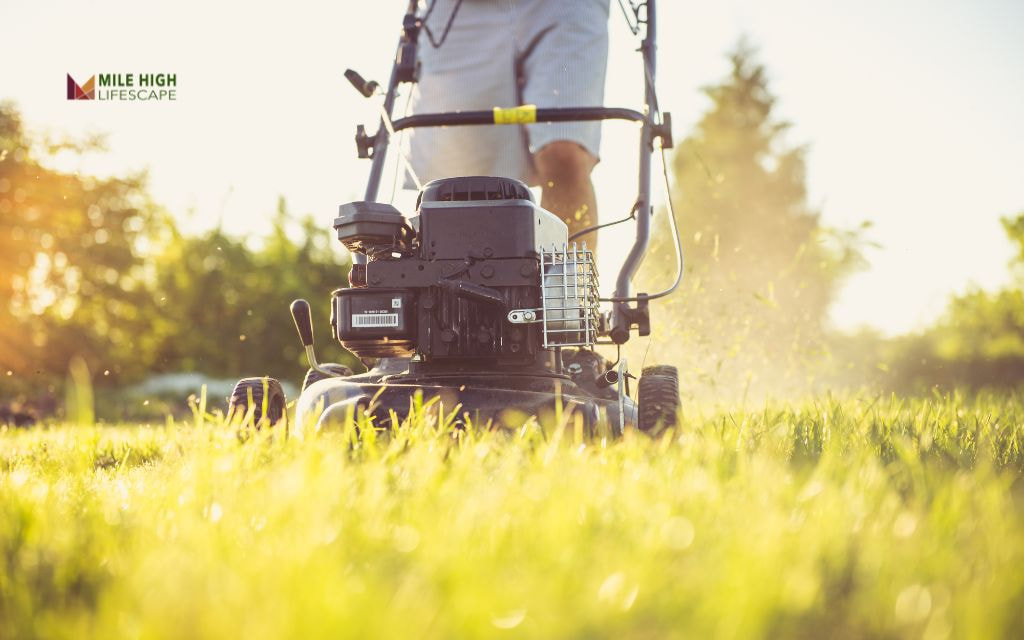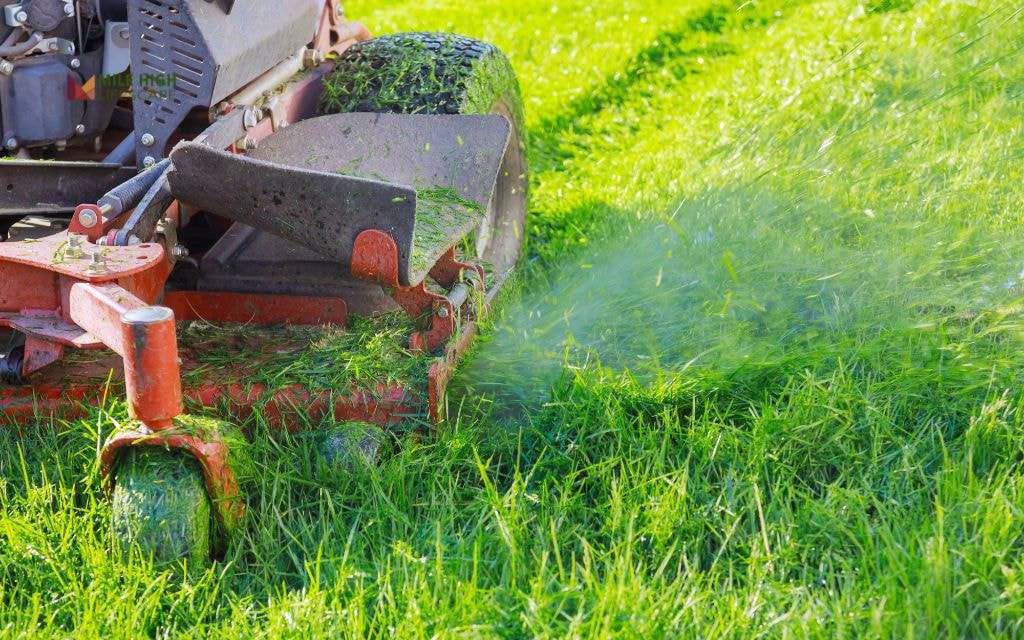At Mile High Lifescape, we understand that time efficiency matters when maintaining your lawn.
When homeowners ask us, “How do you make a lawn mower go faster?” and our answer is straightforward: proper maintenance, engine tuning, and strategic modifications can boost your mower’s speed by up to 30%.
Faster mowing means more time enjoying your outdoor space rather than working on it. With Denver’s short growing season and unique terrain challenges, optimizing your mower’s performance becomes essential for effective lawn care.
Curious about which specific adjustments deliver the biggest speed improvements without risking your equipment? Keep reading and we’ll show you exactly how to achieve this in our step-by-step guide below.
Understanding the Need for Speed in Lawn Mowers
Denver homeowners face particular challenges that make mower speed optimization valuable. Our growing season compresses lawn care tasks into a shorter timeframe compared to other regions.
Large properties in suburban areas may require hours of mowing with standard equipment. Increasing your mower’s speed can reduce your lawn care time by 20-30%, allowing you to complete maintenance before afternoon thunderstorms roll in from the mountains.
Professional landscapers understand that mower efficiency directly impacts customer satisfaction and business profitability.
The same principles apply to homeowners – faster mowing with proper cutting quality transforms lawn maintenance from a time-consuming chore to a manageable task.
How Do You Make A Lawn Mower Go Faster: Easy Step-by-step Guide
Step 1: Basic Maintenance First
Start with fundamental maintenance that often delivers surprising speed improvements. A well-maintained engine operates more efficiently without requiring risky modifications.
Replace your air filter every 25 operating hours. A clogged filter restricts airflow like trying to breathe through a thick cloth. New filters allow your engine to “breathe” properly, immediately improving performance and speed.
Check your spark plug for signs of wear or carbon deposits. A worn plug creates weak sparks that result in incomplete combustion and reduced power.
Replace it annually or if you notice black sooty deposits or damaged electrodes.
Step 2: Engine Tuning for Performance
Proper engine tuning maximizes your existing horsepower without pushing beyond safe limits.
Clean your carburetor to remove gum and varnish buildup that restricts fuel flow. Use a quality carburetor cleaner and compressed air, following your manual’s instructions. Pay special attention to the tiny fuel passages and jets that often clog first.
Change your engine oil using the manufacturer’s recommended weight. Fresh oil reduces internal friction, allowing the engine to spin more freely. For Denver’s unique conditions, consider using synthetic oil that flows better at our elevation.
Step 3: Optimizing Moving Parts
Your mower’s mechanical components significantly impact its speed potential.
Lubricate wheel bearings and axles with silicone-based lubricant, not WD-40. Properly lubricated wheels roll with less resistance, allowing the engine to direct more power to the blade rather than overcoming friction.
Inspect drive belts for proper tension. A loose belt slips and wastes power, while an overly tight belt creates drag. Adjust to manufacturer specifications or replace if you notice cracks or wear.

Step 4: Throttle and Governor Adjustments
The governor limits your engine’s maximum RPM for safety. Minor adjustments can unlock additional speed.
Locate the governor spring – typically a small coiled spring connected to the throttle linkage. Carefully extend this spring by no more than 1/8 inch to allow higher RPM.
Always test in small increments to prevent engine damage.
Clean the throttle linkage using degreaser to ensure smooth operation. Dirt and debris create resistance that prevents the throttle from opening fully, limiting your maximum speed.
Step 5: Blade Optimization
Your mower blade creates significant drag that affects overall speed.
Replace standard blades with high-performance alternatives designed specifically for reduced resistance. Look for words like “high lift” or “reduced drag” in the product description.
Maintain proper sharpness through regular maintenance. A dull blade requires up to 25% more power to cut the same grass, wasting energy that could translate to speed.
Balance your blade after sharpening. An unbalanced blade creates vibration that wastes energy and reduces speed. Use an inexpensive blade balancer from any hardware store to check.
Step 6: Fuel Quality Improvements
The quality of fuel directly impacts engine performance and speed.
Use fresh, high-octane gasoline (91 octane minimum) for improved combustion efficiency. Denver’s high elevation already affects combustion dynamics, making fuel quality especially important.
Consider adding a fuel stabilizer with each tank. This prevents fuel degradation between uses and keeps your carburetor clean, maintaining peak performance over time.
For two-stroke engines, use premium synthetic oil at the proper mixture ratio. Better lubrication reduces internal friction that limits speed potential.
Step 7: Weight Reduction Strategies
Removing unnecessary weight allows your mower to move faster with the same power.
Empty the grass bag more frequently during mowing. A half-full bag weighs significantly less than a full one, reducing the load your mower must push.
Remove non-essential accessories when speed is the priority. Items like mulch kits add weight and create additional drag that slows your mower.
Consider upgrading to lightweight replacement parts if available for your model. Plastic wheels instead of metal or composite decks instead of steel can reduce overall weight.
What Factors Influence Mower Speed?
Engine Power and Displacement
The engine provides the raw power that determines your mower’s maximum potential speed. Understanding your engine helps set realistic expectations for performance improvements.
Most residential walk-behind mowers use engines ranging from 140cc to 190cc (approximately 4-6 horsepower).
Higher displacement generally means more power available for faster operation. Riding mowers typically feature engines from 14-24 horsepower, providing significantly more speed potential.
Electric mowers operate differently, with power measured in watts rather than cubic centimeters. Standard electric models deliver 1000-1800 watts, translating to approximately 1.5-2.5 horsepower. Battery-powered models often have speed limitations to preserve battery life.
For Denver homeowners, remember that our 5,280-foot elevation reduces engine power by about 17% compared to sea level. This natural power reduction affects all engines regardless of size.
Transmission and Drive Systems
How your mower transfers power from the engine to the wheels directly impacts its speed capabilities.
Push mowers rely entirely on your physical effort, with speed limited by how fast you can walk while pushing. These models benefit most from weight reduction and mechanical efficiency improvements.
Self-propelled mowers use several different drive systems:
- Belt drives offer good speed but may slip when wet
- Gear drives provide consistent speed but less adjustability
- Hydrostatic drives offer the most precise speed control through fluid pressure
Riding mowers typically use more sophisticated transmission systems with multiple forward speeds. These transmissions often have adjustable settings that can be optimized for faster operation without engine modifications.
Weight Distribution and Materials
The physical construction of your mower significantly influences how quickly it can move across your lawn.
Heavier mowers require more power to achieve the same speed as lighter models. Steel decks provide durability but weigh significantly more than aluminum or composite alternatives.
Consider the trade-off between durability and speed when evaluating materials.
Weight distribution matters as much as total weight. Front-heavy mowers resist quick direction changes, while balanced designs maneuver more efficiently.
Test your mower’s balance by attempting to tilt it backward slightly – excessive effort indicates poor weight distribution that limits speed.
Denver’s varied terrain magnifies the importance of proper weight distribution. Mowers with balanced weight navigate our slopes and uneven spaces more efficiently than poorly balanced alternatives.

Wheel Size and Tread Design
Your mower’s wheels provide the interface between machine and ground, with significant impact on speed capabilities.
Larger wheels roll more efficiently over uneven terrain, requiring less power to maintain speed. Many high-performance mowers feature larger rear wheels (10-12 inches) compared to front wheels (7-8 inches).
Wheel tread patterns affect both traction and rolling resistance:
- Smooth treads roll faster on flat, dry surfaces
- Aggressive tread patterns provide better grip on slopes but create more resistance
- Middle-ground designs with moderate tread depth offer balanced performance in varied conditions
Wheel bearings quality directly impacts rolling efficiency. Sealed ball bearings reduce friction compared to sleeve bearings, allowing wheels to spin more freely and increasing potential speed.
Cutting Deck Design and Width
The cutting deck creates significant drag that affects your mower’s speed potential.
Wider decks cut more grass per pass but create more resistance that slows forward movement. A 22-inch deck typically allows faster ground speed than a 30-inch deck with the same engine power.
Deck aerodynamics influence cutting efficiency and speed. Modern “high-velocity” decks create improved airflow that reduces power requirements, allowing more energy for forward momentum.
Deck height adjustment affects speed significantly. Cutting at higher settings (3-4 inches) requires less power than cutting at lower heights (1-2 inches), potentially increasing your mower’s speed. This matches well with Denver’s climate, where taller grass heights are recommended for drought resistance.
Safety Considerations and Impacts on Performance
While increasing mower speed can improve efficiency, safety must remain the priority:
- Never disable blade brake systems or safety shields in pursuit of speed. These features protect both the operator and bystanders from serious injury.
- Monitor engine temperature during extended high-speed operation. Denver’s combination of elevation and summer heat creates challenging conditions for air-cooled engines.
- Perform frequent inspections of belts, pulleys, and moving components when operating at increased speeds. Parts experience accelerated wear when pushed beyond stock specifications.
- Consider the impact on warranty coverage – manufacturer warranties typically exclude damage resulting from modifications that increase operating speeds.
- Recognize that speed increases fuel consumption. Plan accordingly with additional fuel reserves for larger properties.

Denver-Specific Lawn Care Considerations
Terrain and Elevation
Denver’s landscape presents unique challenges for lawn mower operation:
- Adjust cutting height based on terrain – higher settings provide better clearance over uneven surfaces while reducing drag that limits speed.
- Consider terrain-specific modifications like upgraded wheels with enhanced traction for sloped properties common in neighborhoods like Golden or Boulder.
- Account for Denver’s elevation effects on engine performance. At our 5,280-foot elevation, engines produce approximately 17% less power than at sea level, affecting maximum speed potential.
- Practice section-by-section mowing techniques on properties with significant elevation changes, focusing downhill movements for gravity assistance that enhances speed.
Climate and Seasonal Considerations
Denver’s climate directly impacts lawn mower performance throughout the growing season:
- Prioritize morning mowing during summer months when cooler temperatures improve engine efficiency and allow higher operating speeds.
- Adjust speed expectations during periods of drought stress when grass becomes tougher and more resistant to cutting.
- Reduce speed in early spring and late fall when cooler temperatures affect engine performance and carburetor settings.
- Consider seasonal carburetor adjustments – slightly richer fuel mixtures for cooler weather and leaner settings during peak summer temperatures.
Frequently Asked Questions (FAQs)
How to increase the speed of a lawn mower?
Replace the air filter, clean the carburetor, sharpen the blade, adjust the governor spring slightly, use high-octane fuel, and ensure proper lubrication of all moving parts.
How to speed up lawn mowing?
Mow in overlapping straight lines, maintain a sharp blade, cut at the optimal height for your grass type, mow when grass is dry, clear obstacles beforehand, and use a wider deck mower if possible.
How to make a lawn mower go 30 mph?
Standard lawn mowers cannot safely reach 30 mph. This would require major modifications including a larger engine, custom transmission, reinforced frame, and safety upgrades that effectively create a different machine. Such modifications void warranties and create serious safety hazards.
What can I spray on my lawn mower to get it started?
Use starter fluid (ether) sprayed directly into the air intake in small amounts. For stubborn cases, try a mixture of 3 parts carburetor cleaner to 1 part engine oil sprayed into the spark plug hole. Never spray flammable liquids directly into the carburetor.
How often should I service my lawn mower to maintain its speed?
Perform basic maintenance (air filter, spark plug, oil change) every 25 operating hours. Complete more thorough service including carburetor cleaning and blade balancing twice per season – once at startup and again mid-season – for optimal performance in Denver’s conditions.
Conclusion
Increasing your lawn mower’s speed can significantly reduce maintenance time when approached correctly. The methods outlined provide measurable improvements while prioritizing safety and equipment longevity. For Denver homeowners, the unique combination of elevation, climate, and terrain requires thoughtful modification rather than aggressive changes.
Before implementing major modifications, consult your owner’s manual for specific limitations. When in doubt, Mile High Lifescape offers professional consultation on equipment optimization tailored to Denver’s specific conditions. Our team provides both preventative maintenance and performance enhancement services that extend equipment life while improving efficiency.
